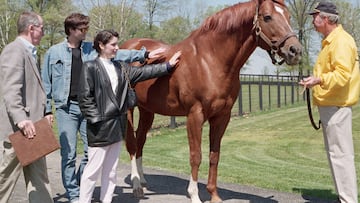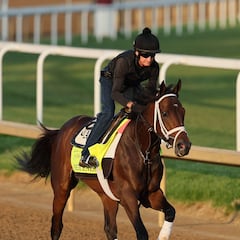How fast was Secretariat? Did he win the Kentucky Derby?
The American thoroughbred racehorse, a triple crown winner in 1973 finished with a record of 16–3–1 and is widely considered to be the greatest racehorse of all time.

Secretariat, a “tremendous, handsome” chestnut thoroughbred set the benchmark for racehorses - and left the bar so high that many believe his achievements may never be matched. He was bred and foaled at the Meadows, a 3,000-acre ranch in Caroline County, Virginia, coming into the world shortly after midday on 30 March 1970 under the supervision of New York Racing Association founder Christopher T. Chenery and his daughter Penny who would become his trainer. It was Penny who chose Secretariat at the Meadow Stables after losing a coin toss with another breeder, Ogden Phipps (Phipps chose weanling filly, The Bride).
You might also enjoy
Secretariat’s debut race in New York
Nicknamed Big Red for his chestnut color and standing at 16.2 hands (66 inches) tall, Secretariat was given his debut run-out in the Maiden Special Weights at the Aqueduct Racetrack in New York on Independence Day 1972. Rode by Paul Feliciano, Big Red crossed the line in fourth but showed blistering speed and stamina to make up seven of over eight lengths on the leading horse in the last 1/4 mile.
Turcotte takes the reins
Secretariat fared even better in his second race at the 1972 Aqueduct Allowance, just over a week later, winning his first race by six lengths. He entered the next race, a $9000 allowance race at Saratoga on 31 July, as the favorite, and won again, this time with Ron Turcotte in the saddle, replacing Feliciano. It was the start of a relationship that would make both household names and ultimately put “Super Horse” Secretariat on the front cover of Time magazine and labelled the “Clark Gable of horses” by Vogue.
“He rode me to the pinnacle of my career,” recalled years later. “I remember very well the first time I saw him. I said, ‘Oh, my God… who is that beautiful colt?! It was love at first sight and love at first ride. He was beautiful, so gentle, so intelligent...”
Sounds like a lot of folks wish they could travel back in time to watch Secretariat's win in the 1973 Kentucky Derby...
— Kentucky Derby (@KentuckyDerby) May 2, 2024
Let's relive Big Red's historic victory in the 99th #KyDerby 💙 https://t.co/L190e2WPKn pic.twitter.com/RaW3sT0fnB
Chenery and trainer Lucien Laurin gave Turcotte the mount for the following year’s Triple Crown season. On 5 May 1973, Secretariat and Turcotte crossed the line at Churchill Downs way ahead of the competition, with the clock registering 1:59.4 - the fastest time in Kentucky Derby history over one and a quarter miles. “He just took off,” Turcotte remembered. “We won easy, setting a new track record”.
Secretariat wins the 1973 Preakness Stakes pic.twitter.com/yDhxcuiLlH
— Sports & Betting History by BestBettingSites (@CDCHistory) May 15, 2020
Secretariat sets new course record in Baltimore
A fortnight later at the Preakness Stakes, at Pimlico Race Course in Baltimore, Secretariat was last in a field of six heading into the first turn but then came tearing down the straight and was leading by a length and a half down the back stretch. In front of 61,657 spectators, Big Red won by 2+1⁄2 lengths ahead of Sham with a time of 1:55 which was revised in 2012 under petition from Chenery and later marked down to 1:53 - another track record.
Related stories

Fierce favorite
A few weeks later on 9 June, Secretariat clinched the Triple Crown, winning the 105th Belmont Stakes by an incredible 31 lengths, the biggest margin of victory in Belmont history, with another record time of 2:24. His performance at Belmont Park is considered the greatest race ever run by a thoroughbred racehorse. Only 11 horses have achieved the US Triple Crown in almost a century of racing and Secretariat’s records in each of the constituent races stand to this day, over half a century later.
In his brief but spectacularly brilliant 16-month career, Secretariat came first in 16 races, second three times, and third once, winning a total of $1,316,808. He won five Eclipse Awards, including Horse of the Year, was nominated to both the National Museum of Racing and Hall of Fame in 1974. He retired to a stud farm at the end of 1973 and lived to the ripe old age of 19 but sadly had to be put down in 1989 after being diagnosed with laminitis, a painful and debilitating hoof condition.

Complete your personal details to comment